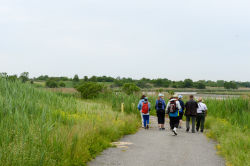Freshkills Park
Parks, Sanitation And Friends Celebrate The 10th Anniversary Of The Fresh Kills Landfill Closure
IMMEDIATETuesday, March 22, 2011
No. 13
http://www.nyc.gov/parks
Parks Commissioner Adrian Benepe, Sanitation Commissioner John Doherty, Staten Island Borough President James Molinaro, Council Members Vincent Ignizio and Deborah Rose, Director of the Mayor’s Office for Long-Term Planning & Sustainability David Bragdon, representatives from partner City agencies and organizations, and members of the Staten Island community celebrated the 10th anniversary of the Fresh Kills Landfill closing by welcoming a barge of trees and planting them at the future location of the Freshkills Park South Park area.
“Mayor Michael Bloomberg, Staten Island Borough President Molinaro, Staten Island elected officials and community members have been instrumental in developing the vision for this major accomplishment unfolding before our eyes. Freshkills Park will have unparalleled vistas and recreation experiences, with lessons to teach about waste and reuse, the capacity to demonstrate new strategies for reclaiming land and renewable energy, and a new model for 21st century parks,” said Parks Commissioner Benepe. “A talented landscape architecture firm, James Corner Field Operations, is working with our Freshkills Park Administrator and her staff, to realize the vision as designs move off the drawing board and into construction. And it is all made possible thanks to the tremendous work of our partners at the Department of Sanitation, who ensured the potential for Freshkills Park as the mounds are capped and nature takes hold of this site.”
“Sanitation is proud to be working with the Parks Department as Fresh Kills is transformed into a world-class park. When Fresh Kills opened in 1948, it was only expected to be used for two to three years, but it was more than a half a century later when the Fresh Kills Landfill was finally closed,” said Sanitation Commissioner Doherty. “Since then, the City has implemented the Mayor’s comprehensive borough-based Solid Waste Management Plan which is a cost-effective, reliable and environmentally sound system of managing the City’s 11,000 daily tons of solid waste. We are pleased that this property will one day become a 2,200-acre recreation area.”
“The team effort at Fresh Kills exemplifies PlaNYC: pulling all the agencies together to achieve multiple objectives. This project is another step forward in creating a greener, greater New York City,” said Director Bragdon. “The future park and its landfill management system demonstrate what New York does best—innovate and set the standard for similar projects around the country and the world.”
Staten Island Borough President James Molinaro said, ”It took the determination of then-Borough President Guy Molinari and the cooperation of Governor George Pataki and Mayor Rudy Giuliani to finally end one of the country’s worst ecological nightmares.”
Fifty-three years of landfill operations came to an end on the morning of March 22, 2001. New York City Department of Sanitation scow No. 123 departed the North Shore Marine Transfer Station in Flushing, Queens, with 600 tons of garbage, the last delivery of waste to the Fresh Kills Landfill. Crowds along the waterfront celebrated the last barge and the arrival of the day when New York City’s residential waste would no longer be deposited on the west shore of Staten Island.
The 2,200-acre site has begun the transition from closed landfill to world-class park. Together, the Department of Sanitation and the Parks Department oversee the reclamation and redevelopment of this land. Sanitation has worked to cap, monitor and maintain the infrastructure under the planned park, including a system collecting natural gas to heat 22,000 homes on Staten Island. The Parks Department continues design and construction of Freshkills Park, which will have five main areas: the Confluence, North Park, South Park, East Park and West Park.
Construction has begun for Owl Hollow Park and Schmul Park, adjacent sites that will provide access to the greater Freshkills Park site. Owl Hollow Park, a previously undeveloped 21-acre site, will offer four synthetic turf soccer fields (two of which will be lighted) and a LEED certified comfort station complete with green roof, geothermal heating and cooling and a wind turbine that will be able to power the building. A newly-renovated Schmul Park will offer playground, handball and basketball courts, flowering meadow, native grass areas and rain garden.
South Park, the first park development on the landfill area, will focus on providing active recreational opportunities to park visitors while maximizing access to the site's spectacular landscapes and vistas. The 20-acre project features play and picnic areas, scenic overlooks, meadows and lawns for informal games and events, a 1-mile bike loop, a race and game strip, two softball and little league fields and views of a variety of forest, grassland and wetland habitats. A permanent public art installation is being developed for South Park by Department of Sanitation Artist-in-Residence Mierle Laderman Ukeles.
The North Park project is currently in the permitting process and is expected to go out to bid this year. North Park will focus on passive recreation and nature appreciation. This area will include photovoltaic-powered lighting, a path to the waterfront, a picnic area, a bird observation tower, an overlook deck, and a tree nursery and Founder Seed farm operated in partnership with the Parks Department’s Greenbelt Native Plant Center.
While the full build-out will continue in phases for the next 25 years, development over the next several years will focus on providing public access to the interior of the site and showcasing its unusual combination of natural and engineered beauty.
- 30 -
Check out your park's Vital Signs
Clean & Safe
Green & Resilient
Empowered & Engaged Users
Share your feedback or learn more about how this park is part of a
Vital Park System










